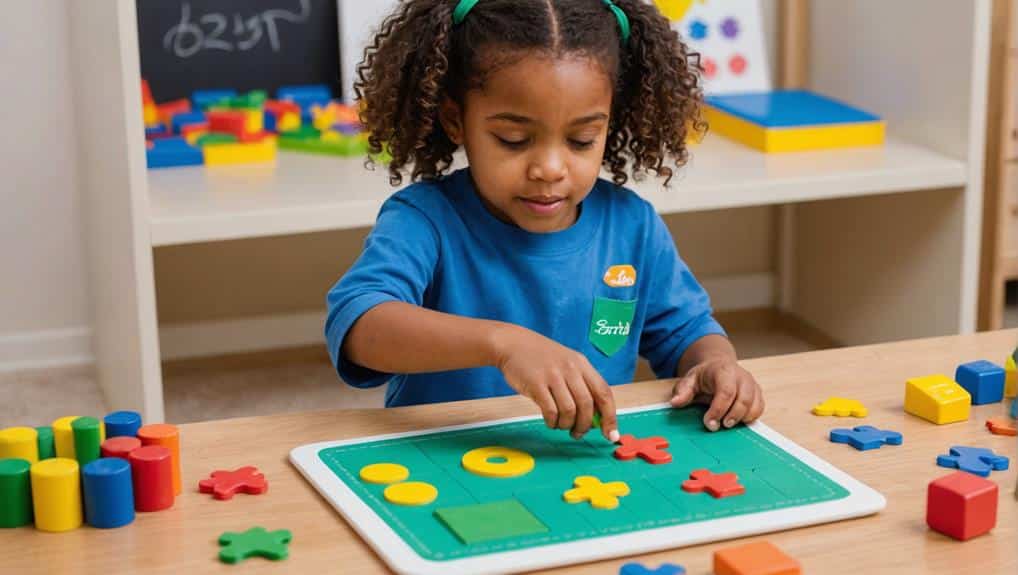Key Takeaways
- The sensory processing approach aids in managing sensory experiences and improving social interactions.
- Self-care and play interventions enhance fine motor skills, play skills, and social interactions.
- The cognitive development approach promotes cognitive skills, supporting children in school and social interactions.
- Handwriting training improves fine motor and writing skills, aiding overall development and school tasks.
- The coaching model works closely with families to address developmental delays and create personalized treatment plans.
Understanding Pediatric Occupational Therapy
Pediatric occupational therapy, a specific discipline within the broader field of occupational therapy, is essential in enhancing children’s skills necessary for daily living. This therapy focuses on fine motor skills, sensory processing, self-care, play, and cognitive development. For example, children on the autism spectrum may find it difficult to maintain eye contact, which can impact their social interactions.
Through tailored therapy approaches, pediatric occupational therapists can provide strategies to manage sensory challenges related to eye contact and promote effective communication.
Its primary aim is to overcome obstacles children may face in school, play, and social interactions, promoting their overall well-being and development. Specialized interventions in pediatric OT, such as sensory integration therapy, handwriting training, fine motor skill development, visual perceptual skills training, and social skills groups, are designed to help children reach their developmental milestones. These interventions are carefully designed based on the child’s needs and abilities.
Pediatric occupational therapists work closely with families, using a coaching model to address developmental delays and create personalized treatment plans. Their key asset is providing skills and support for successful routines like sleep, mealtime, playtime, potty time, and dressing. Therefore, pediatric occupational therapy is a vital support system, helping children thrive daily.
Need for Occupational Therapy
Recognizing the significant role of pediatric occupational therapy in improving daily living skills, it becomes increasingly clear why this targeted intervention is necessary. This treatment is vital in cultivating children’s fine motor skills, sensory processing, self-care, play, and cognitive abilities. It provides a holistic approach to address specific challenges in school, play, and social interactions that could hinder a child’s development.
Early diagnosis and intervention can benefit children with autism, leading to timelyAutisms to occupational therapy. This therapy helps improve motor skills and plays an essential role in fostering communication abilities.
Occupational therapy is not merely a remedial measure but a proactive strategy to ensure the overall well-being of children. It fosters independence and promotes skills that are integral to their daily activities. It helps children navigate their world by improving their motor skills for tasks as simple as holding a pencil to more complex activities like social interactions.
Occupational therapy provides techniques and strategies for helping children struggling with sensory processing issues better manage their sensory experiences. The treatment is also indispensable for children with cognitive challenges, as it improves cognitive skills.
In essence, occupational therapy is not just about therapeutically addressing impairments but equipping children with the necessary skills to navigate and succeed in their world.
Occupational Therapy Vs. Physical Therapy

It is informative to compare the pediatric occupational therapy approach with physical therapy, as both play pivotal roles in child development. Significantly, these therapies have unique key features and employ varied therapeutic techniques to improve the child’s functionality and well-being.
Understanding these differences will provide us with a more detailed view of how each contributes to the progression of a child’s physical and functional capacities. For example, pediatric occupational therapy might include personalized methods, such as drama therapy, to address specific needs and preferences, including challenges that autistic children may face with eye contact.
These tailored methods can enrich a child’s comfort and confidence, improving overall well-being. Recognizing the variety of techniques utilized in both occupational and physical therapy can help us appreciate the complexity of child development and the significance of personalized therapeutic interventions.
Distinguishing Key Features
Delving into the main differences between occupational and physical therapy, we find that each targets distinct yet significant aspects of a child’s development. Specifically, occupational therapy, in the pediatric context, revolves around enhancing a child’s ability to participate effectively in daily activities. This is notably significant for autistic individuals, as this type of therapy can provide strategies to manage sensory challenges related to eye contact, thereby promoting better communication and overall well-being (eye contact challenges).
The treatment fosters vital skills such as fine motor skills, sensory processing, self-care, play, and cognitive abilities. Occupational therapy aims to bolster a child’s well-being and development by addressing specific skill deficits.
On the other hand, physical therapy primarily focuses on improving a child’s movement, posture, mobility, strength, and coordination. It employs carefully crafted exercises and techniques to promote physical functioning and address movement-related impairments.
Despite these differences, it is essential to understand that both these therapies play complementary roles in pediatric care. By targeting different aspects of development and function, they collectively form an integrated approach to helping children succeed. Essentially, the main distinguishing features of occupational and physical therapy lie in their distinct treatment goals and methods, yet their shared commitment to child development is undeniable.
Therapeutic Techniques Comparison
With a keen emphasis on everyday tasks and crucial skills, pediatric occupational therapy utilizes a variety of activities and interventions crafted to improve a child’s development. This approach is often compared with physical therapy, which mainly focuses on physical function, mobility, strength, and coordination.
Both therapy types employ distinct techniques to address the child’s specific concerns. For instance, occupational therapy might utilize sensory integration methods, therapeutic activities, and strategies to promote skill development. On the other hand, physical therapy might concentrate on exercises and techniques to enhance physical functioning and tackle movement-related challenges.
The table below offers a brief comparison:
| Therapy Type | Focus | Techniques |
|---|---|---|
| Occupational Therapy | Daily activities and crucial skills | Sensory integration, therapeutic activities, skill development |
| Physical Therapy | Physical function and mobility | Exercises, movement methods |
Together, occupational and physical therapy play essential roles in children’s lives, assisting them in overcoming obstacles and improving their abilities in their daily actions. Each treatment offers distinct advantages, and their combined utilization can be revolutionary for children needing support.
Impact on Child Development
The impact of both occupational and physical therapy on children’s development is immeasurable, profoundly influencing the quality of their lives. Pediatric occupational therapy targets necessary skills such as sensory processing, cognitive development, and social interactions, enhancing the child’s capability to perform daily activities independently. This therapy is particularly effective for children with autism, as it acknowledges autism perspectives and caters to their specific needs, facilitaAutismheir navigation in the world.
As autism suggests, it’s vital to recognize and support the diverse voices of autistic individuals. This provides the child with a strong foundation for growth and promotes overall well-being and development. On the other hand, physical therapy primarily focuses on improving physical function and mobility, addressing impairments related to movement and posture. It strengthens and coordinates the body, enhancing the child’s ability to participate in physical activities, an essential aspect of child development.
Both therapies play a synergistic role. Where physical therapy reinforces the child’s physical capabilities, occupational therapy empowers them to utilize them daily, strengthening their sensory processing abilities and necessary skills. Combining these therapies enables children to overcome challenges, thrive in their environments, and succeed in their endeavors. Ultimately, the approach adopted by both therapies contributes significantly to a child’s holistic development.
Conducting Occupational Therapy Sessions
Occupational therapy sessions significantly influence a child’s path toward improved well-being and daily success. These sessions typically encompass initial assessments, goal-setting, activity analysis, intervention planning, and progress monitoring. As part of this process, incorporating mindfulness activities, such as meditation and breathing techniques, can be beneficial and have been recognized as helpful self-care strategies for children with autism.
Autism therapy ensures each session is customized to meet the child’s unique developmental needs. Therapists use specially designed activities to improve fine motor skills, sensory processing, cognitive abilities, self-care routines, play, and social skills, holistically fostering physical, mental, and emotional growth.
Progress monitoring is a crucial component of occupational therapy sessions. Therapists continually assess the child’s development, adjusting interventions as necessary to ensure the most effective outcomes. This constant observation and adjustment ensures the child is always working towards achievable goals at a pace suited to them.
Lastly, collaboration is critical in this process. Therapists engage with the child, their family, and educators, seeking feedback and adjusting interventions based on changing needs and goals. This collaboration ensures the ultimate goal of improving the child’s overall well-being, development, and success in daily routines is achieved.
Determining Child-Specific Interventions

Determining child-specific interventions in pediatric occupational therapy involves carefully evaluating the child’s talents, limitations, and goals. Part of these interventions may entail advocating for inclusive education and skill-building initiatives, just as autism advocates do, to foster a child’s independence. This detailed assessment allows the therapist to formulate customized strategies that target particular areas such as fine motor skills, sensory processing, cognitive development, self-care, and social interactions.
Through tailored interventions, the occupational therapist enables the child to overcome challenges, reach developmental milestones, and thrive in daily activities.
Assessing Individual Needs
How can pediatric occupational therapists effectively determine child-specific interventions? The answer lies in meticulously evaluating distinct requirements through thorough examinations. Occupational therapists utilize various tools, including standardized assessments, observations, and parent discussions, to pinpoint each child’s obstacles. This holistic method guarantees that a child’s abilities, limitations, and objectives are all considered equally, offering a complete understanding of their skills and requirements.
These evaluation outcomes steer the creation of customized treatment plans to fulfill the child’s needs. This implies that each intervention is tailored to the child’s circumstances, addressing fine motor abilities, sensory processing, self-care, play skills, and cognitive growth.
Grasping a child’s unique needs is not solely about pinpointing shortcomings; it is also about acknowledging their strengths and utilizing them to help them grow and progress. Pediatric occupational therapists can develop interventions that genuinely help humanity through meetings by adopting this compassionate, intricate approach.
While grasping a child’s specific needs is vital, the actual effectiveness of pediatric occupational therapy lies in implementing customized strategies based on these particular assessments. A cornerstone of this practice is the development of personalized interventions that holistically address each child’s distinct challenges, whether it be fine motor skills, sensory processing, or cognitive development.
Creating personalized plans is a dynamic process, adjusting and evolving based on the child’s progress and changing needs. Each underscores the importance of continual observation, reassessment, and modifying strategies to optimize their impact.
Child-specific interventions are not limited to addressing developmental hurdles. They also aim to enable children to succeed in daily activities, play, and social interactions. By focusing on these areas, therapists can significantly improve each child’s skills and abilities, enhancing their quality of life and fostering greater self-reliance.
The success of pediatric occupational therapy hinges on this personalized approach. The careful crafting of tailored strategies, shaped by the child’s specific needs and continuously adapted to their progress, paves the way for meaningful and lasting change.
Examples of Pediatric Occupational Therapy Interventions
Pediatric therapy interventions, a cornerstone of occupational therapy, are designed with the child’s specific needs at the forefront. These thoughtfully crafted intervention plans often include play-based activities that support skill development. Play allows children to investigate, express, and engage in a non-threatening, enjoyable environment, which enriches their learning process.
Sensory approaches form another significant aspect of pediatric therapy interventions. These approaches address children’s sensory integration challenges, fostering their ability to process and respond to sensory information effectively. Sensory approaches help children interact better with their environment, improving social and emotional growth.
Skill training, another critical component of pediatric occupational therapy, employs imaginative and interactive methods to improve learning. This could include fine motor activities, body coordination exercises, or cognitive tasks designed to encourage children’s independence in daily tasks.
Involving parents in treatment planning is a critical part of the process. Their input and support can significantly improve the effectiveness of the therapy, contributing to the child’s progress and success. Therefore, these examples of pediatric therapy interventions demonstrate occupational therapy’s detailed, individualized, and compassionate approach to helping children thrive.
Benefits of Pediatric Occupational Therapy

Building on the premise of tailored intervention plans, the advantages of pediatric occupational therapy become increasingly apparent. Occupational therapy interventions target children’s specific requirements, improving fine motor skills, sensory processing, and cognitive skills and promoting overall growth.
These therapies are pivotal in assisting children to overcome challenges in school, play, and social interactions, nurturing their well-being, and supporting their development. These interventions concentrate on sensory integration for children with sensory processing needs, providing a priceless support system.
Pediatric occupational therapy collaborates with parents and educators to boost the child’s skills for successful routines, foster academic achievement, and improve overall welfare.
| Benefit | Impact | Personal Reaction |
|---|---|---|
| Enhanced Fine Motor Skills | Improved ability to grasp and manipulate objects. | Joy at witnessing improved independence. |
| Improved Sensory Processing | Better response to the environment. | Relief at decreased meltdowns or overreactions. |
| Successful Routines | Ease in daily activities. | Satisfaction at seeing the child’s progress and increased confidence. |
In essence, pediatric occupational therapy’s advantages are diverse. They extend beyond the child’s immediate needs, nurturing their potential and aiding in their progress toward success.
Early Intervention in Pediatric OT
Given the critical nature of early development, early support in pediatric occupational therapy is crucial in addressing developmental delays in children from birth to three years old. This approach leverages the brain’s adaptability during these formative years, facilitating the acquisition of necessary life skills.
Occupational therapists meticulously analyze activities in these initial stages, identifying skill deficits that may hinder the child’s growth. Using these evaluations, therapists develop Personalized Treatment Plans tailored to each child’s and their family’s distinct needs. These plans offer focused, goal-oriented strategies to overcome identified developmental obstacles, nurturing the child’s ability to engage meaningfully with their surroundings.
The Coaching Model is Central to early support success, wherein therapists work closely with families, providing guidance and assistance. This hands-on approach enables parents to integrate therapeutic strategies into their daily routines, promoting smooth skill development for their children. The coaching model also cultivates a supportive environment that encourages children to thrive, embodying our shared goal to assist others by aiding every child in achieving success.
Identifying Developmental Challenges

Plotting developmental obstacles early in a child’s journey is a cornerstone of pediatric occupational therapy. Timely identifying these obstacles allows therapists to intervene effectively, ensuring that children can thrive and overcome hurdles in their daily activities.
Recognizing signs like fine motor skills hurdles, sensory processing challenges, and visual processing issues is crucial for developing a tailored therapy plan. It also paves the way for a child to navigate the world more smoothly. The role of parents and caregivers in this process cannot be overstated. Their advocacy for the child’s well-being and their pursuit of appropriate support are critical elements in successfully managing developmental hurdles.
Pediatric occupational therapy is not just about addressing physical difficulties but also understanding a child’s individual developmental needs. With the proper support, early detection of developmental obstacles can significantly improve a child’s quality of life. This tale of achievement begins with the initial step of identification, highlighting the invaluable role of early detection in pediatric occupational therapy.
Improving Fine Motor Skills
Improving fine motor skills is an essential part of pediatric occupational therapy. Fine motor skills development is a targeted outcome of specific interventions. These skills, including hand-eye coordination and agility, are necessary for daily activities like writing, dressing, and using utensils.
Children can improve their fine motor skills through pediatric occupational therapy, leading to increased independence, enhanced self-esteem, and better overall functioning. These skills’ role extends beyond daily tasks, contributing significantly to academic success.
Therapy interventions to enhance fine motor skills can include:
- Grasping objects
- Manipulating small items
- Hand strengthening exercises
Each activity contributes to developing hand-eye coordination and agility, making it an essential component of pediatric occupational therapy. By engaging in these interventions, children can experience a noticeable improvement in their fine motor skills, setting them on a path to success. This process, while demanding, is a fundamental part of helping children realize their full potential and succeed in their endeavors.
Role of Feeding Skills in OT

In pediatric occupational therapy, feeding skills play a crucial role. They contribute to overcoming eating challenges and significantly improve a child’s nutritional well-being. By focusing on these areas, therapists can promote independence, enhance development, and establish a positive relationship between the child and their food.
Overcoming Eating Challenges
Addressing eating obstacles is crucial in pediatric occupational therapy, specifically focusing on developing children’s vital feeding skills. Occupational therapists (OTs) provide tailored interventions to improve the mealtime experiences of children facing eating difficulties.
These interventions include:
- She teaches the child how to grasp and coordinate with adaptive utensils to make self-feeding easier.
- I was instructed on effective chewing and swallowing techniques to ensure safe eating.
- We are introducing texture modifications to food, which can benefit children with sensory issues or oral motor difficulties.
Mastering these feeding skills improves a child’s independence and contributes significantly to their nutritional well-being and overall development. Every step can bring challenges, from the initial spoonful of solids to the progression to self-feeding. With their specialized knowledge and empathetic approach, OTs can guide children and their families through these obstacles, facilitating a positive and stress-free mealtime environment. Hence, the role of OT in overcoming eating obstacles is pivotal in helping children succeed.
Enhancing Nutritional Well-being
Promoting peak nutritional well-being in children is a pivotal aspect of pediatric occupational therapy, greatly influenced by feeding skills. Addressing feeding challenges is fundamental to the therapy process. Through targeted interventions, therapists assist children in developing essential skills such as utensil grasping, coordination, and chewing. These strategies, including introducing adaptive utensils and texture modifications, play an integral part in overcoming eating difficulties, fostering a child’s independence, and promoting nutritional well-being.
Occupational therapy also plays a critical role in addressing picky eating habits. By cultivating a healthy relationship with food, therapists ensure successful mealtimes. They aim to make mealtimes less stressful and inclusive, enhancing the child’s overall well-being.
Frequently Asked Questions
What Are the 5 Intervention Approaches in OT?
The five intervention approaches in Occupational Therapy encompass sensory integration therapy, fine motor skills development, visual perceptual skills training, social skills groups, and play-based therapy, all designed to foster a child’s holistic development.
What are the most effective pediatric OT strategies for improving my child’s motor skills?
Pediatric OT strategies like play-based activities and targeted exercises can significantly enhance your child’s fine and gross motor skills. These approaches are tailored to meet each child’s unique needs, making therapy effective and engaging.
What Is the Pediatric Approach to Occupational Therapy?
The pediatric approach to occupational therapy centers on enhancing children’s abilities for daily living via play-based interventions, sensory techniques, and customized treatment plans. It strongly emphasizes family involvement and social participation.
What Are Pediatric Occupational Therapist Approaches?
Occupational therapists utilize customized, play-based interventions, sensory integration strategies, and skills training. They collaborate with families for tailored treatment plans, fostering independence and enhancing the child’s ability to interact effectively with their environment.
What Are Some Examples of Using a Top Down Approach to OT Intervention With Children?
Top-down approaches in pediatric occupational therapy focus on children’s comprehensive goals, breaking down tasks like self-care or school activities into manageable steps. This promotes independence, motivation, and successful engagement in therapy.


Recent Comments